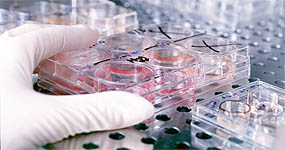Laboratory Safety Manual

Discover the Laboratory Safety Manual for policies, procedures, and services for campus research and teaching laboratories.
The UC San Diego web-based Laboratory Safety Manual, which includes the Chemical Hygiene Plan, is a series of pages assembled as a comprehensive resource of laboratory safety policies and procedures.
Cal/OSHA mandates that all employees be informed of the contents, know the location, and have ready access to the employer's Laboratory Safety Manual & Chemical Hygiene Plan.
Be ready for the inspector
Learn what to expect from inspectors and how to make your lab inspection-ready:
Biological safety
Select Agents
Chemical safety | Chemical Hygiene Plan
Related links:
- Chemical Safety index
- ChemCycle, chemical reuse program
- Hazard Control Plan (HCP)
- Specific Chemical Safety Guidelines
- Globally Harmonized System of Classification and Labeling of Chemicals
- Safety Data Sheet (SDS) Sources
- Safety Training for Researchers
- California Green Chemistry Initiative, California Department of Toxic Substances Control
Compressed gases
Controlled substances
Electrical safety
Emergency procedures
- Consult emergency preparedness resources for researchers
- Emergency Guide
Emergency phone numbers:
- Call 9-1-1 from campus phones
- From other phones:
- UC San Diego Police (858) 534-HELP (4357)
- Medical Center Security (619) 543-6111
- Poison Control (800) 222-1222
Important! Chemistry-Biochemistry personnel must:
- Report serious incidents immediately: Call 9-1-1
- Immediately secure any incident scene from all access and preserve all evidence for no less than 24 hours.
Hazardous materials spills:
- Clean Up Chemical Spills in Laboratories
- Small-Scale Chemical Spill Kits
- Clean Up Minor Radioactive Contamination
- Get Safety Data Sheets
Emergency preparedness:
Equipment and supplies
Equipment
- 3D Printing
- Autoclaves
- Centrifuge Safety
- Decontamination Clearance for Equipment or Facilities (Green tag)
- Defrosting a research freezer (PDF)
- Environmental Rooms
- Eye Wash and Emergency Shower Guidelines
- Hot Plate Usage and Heating Reactions
- Knowing What's in Your Research Freezer (PDF)
- Magnet Safety Guidelines
- Personal Protective Equipment (PPE)
- Special Refrigerators for Flammable Liquids Storage
- Tissue Culture Rooms: Hand Washing Sink Requirement
Supplies
Fire safety
First-aid kits
Forms
- See EH&S Forms.
Fume hoods | Engineering controls
Hazardous materials & hazardous waste
Human subjects
Lab design
See below for more resources and guidance:
Laboratory ergonomics
- Ergonomic Awareness: Risk Factors for Laboratory Workers
- Ergonomic Resources
- Ergonomic Training
Laboratory relocation, closure, and clearance
How to:
Laboratory safety responsibilities
Laboratory personnel duties and responsibilities include:
- Complete all required health, safety, and environmental training.
- Review and follow relevant laboratory authorizations and safety manual(s).
- Follow oral and written laboratory safety rules, regulations, and standard operating procedures (SOP) required for assigned tasks.
- Keep your work areas safe and uncluttered.
- Review and understand the hazards of materials and processes in your laboratory prior to conducting work.
- Take appropriate measures to control identified hazards, including consistent and proper use of engineering controls, personal protective equipment (PPE), and administrative controls.
- Understand the capabilities and limitations of PPE issued to you.
- Get prior approval from your PI/laboratory supervisor for the use of restricted chemicals and other materials.
- Consult with PI/laboratory supervisors before using highly hazardous materials or conducting certain higher risk experimental procedures.
- Report accidents and unsafe conditions immediately to the PI/laboratory supervisor.
- Participate in the medical surveillance program, when required.
- Inform the PI/laboratory supervisor of any work modifications ordered by a physician as a result of medical surveillance, occupational injury, or exposure.
- Follow basic laboratory security requirements for hazardous or controlled materials
Related links:
Laboratory security
Laser safety
My Research Safety Web portal
Read about My Research Safety, a Web portal for centralized access to your Environment, Health & Safety (EH&S) audits, inventory, and authorizations.
- Link to My Research Safety at myresearchsafety.ucsd.edu.
Nanotechnology
Personal protective equipment (PPE)
- PPE Support for Researchers - UC San Diego's laboratory PPE Distribution Program
- Personal Protective Equipment
- Glove Overview
Related links:
Principal investigators
Radiation safety
Report injury, illness, or exposure
Report all work-related injuries, illness, or hazardous material exposures immediately:
- See What to Do if a Work-Related Injury or Illness Occurs for procedures.
Important! Chemistry-Biochemistry personnel, follow special incident reporting instructions:
Research Assistance Program
- Research Assistance Program Contacts
- Research Assistance Program / laboratory audits
- My Research Safety web portal – Manage your Environment, Health & Safety (EH&S) audits, inventories, and authorizations online
Risk Assessment and Mitigation
Shipping Materials & Export Control
Training
- Safety Training for Researchers: Safety training requirements for UC San Diego researchers
- Technical Research Safety Training
- Research Facility Classifications
- Laboratory Safety Videos
- Lab Student Safety Education & Safety Exam: UC San Diego Department of Chemistry and Biochemistry
- UC Systemwide Lab Safety Training
Vivarium safety
Warning signs | Labels
Learn about hazard and caution signs and labels you may see at UC San Diego and what they mean.
Learn about the Globally Harmonized System of Classification and Labeling of Chemicals (GHS). GHS-compliant labels that include a harmonized signal word, pictogram, and hazard and precaution statements for each hazard class and category will begin to appear in our chemical inventories soon.
UC Lab Safety Resources
Policies and regulations
State
- California Code of Regulations, Title 8, Section 3203 - Injury & Illness Prevention Program
- California Code of Regulations, Title 8, Section 3380 et al - Personal Protective Equipment
- California Code of Regulations, Title 8, Section 5191 - Occupational Exposure to Hazardous Chemicals in Laboratories ("The Laboratory Standard")
UC San Diego
- Delegation of Authority and Potential Risk: EH&S - UC San Diego Administrative Responsibilities Handbook
- UC San Diego PPM 516-19 Laboratory Safety
- UC San Diego Campus Notice - August 24, 2012, Chancellor to All Academics at UC San Diego: Laboratory Safety